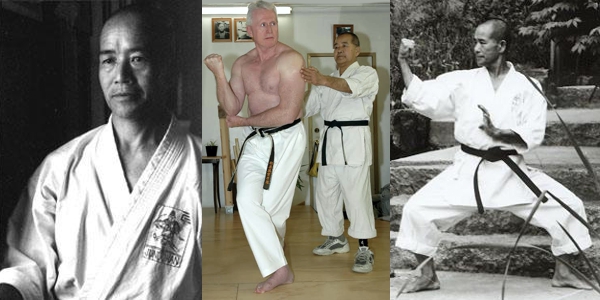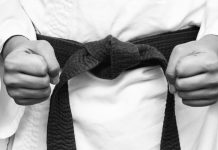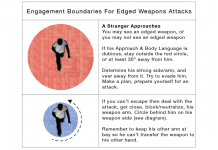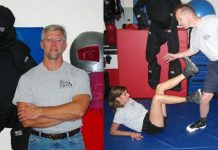Ed Sumner Sensei’s Training With Teruo Chinen Sensei:
The first time I met Teruo Chinen Sensei was at the annual college tournament, held that year at Washington State University. I had met Ernie Breneke at a tournament in Portland, and he had (without asking Sensei first) invited me to bring my team of high school boys to the tournament. Although it was a college tournament, Sensei very graciously allowed us to participate.
Sensei did a demonstration, and as I watched, something was blindingly clear to me. No disrespect to the people I had trained with in Okinawa. They were all amazing in their own right. But Sensei Chinen just seemed to be at a completely different level, particularly in his jiu kumite.
I did Seisan Kata in the Kata competition. I think it may actually have caused Sensei some pain to watch, it was done so poorly. None the less, Sensei invited me to come to Spokane to visit and train.
As a starving student with a wife and two little boys, we had no money for a hotel. Sensei kindly offered the Dojo as a place for us to sleep. It was in the dead of winter, and quite cold. Sensei helped us settle in, and then left. He was back in about ten minutes with some logs to burn in the fireplace to keep us warm for the night.
Training was wonderful, and difficult. And I knew that I had to move to Spokane and train with Sensei. Sensei was kind enough to accept me as a student. I suspect that he felt that he really needed to fix that Seisan!
Sensei even drove us around Spokane, showing us some sights, including a view from the hill, overlooking a night scene of Spokane under a brilliantly clear star-lit sky. It was beautiful.
As soon as I finished the semester of school that I was in, I transferred to Eastern Washington University, and began my training with Sensei in earnest.
I first arrived at the Dojo with a Nidan ranking from a Goju Ryu Dojo in Okinawa, and an extensive collection of bad habits in my techniques (developed while I had been self-practicing) that would require years of effort to correct.
Not only did Sensei succeed in fixing many of my bad habits in technique, he also gave me many real, lasting, and deeply valuable lessons in character development.
Sensei taught me so much, and so much beyond the ways of kicking and blocking and punching. The daily example Sensei set was the first building block of my learning.
In addition to the physical mastery of Sensei’s technique is Sensei’s mastery of teaching. Sensei always seemed to know just the right moment to get inside my head and pull me up to the next level of understanding.
Wow! I’d never be able to jump rope for 30 minutes!
I remember one Sunday when two other yudansha and I were being pests (like usual) and taking up Sensei’s time at home. We were talking about some of Sensei’s early training, and Sensei made an off-hand comment about jumping rope for 30 minutes before training as a warm-up. We were all astonished. “Wow! I’d never be able to jump rope for 30 minutes!” we all said. Sensei didn’t say a word, and the conversation went in a different direction. We all forgot about it.
Then, a few days later, when we all got to practice a little early on the same day, Sensei yelled out our names. “Get jump rope. Jump 10 minutes! “We all shouted “YES SENSEI!” and ran to the back of the Dojo to retrieve jump ropes and get started. We did okay for the first 5 minutes or so, and then we all started to fade a little. We’d miss jump, and hit our feet with the rope, and have to start again, and I’m sure we all looked a little like we were about to die. We struggled along for the last few minutes, eyes fixed on the clock on the Dojo wall, watching desperately for the last seconds of those ten minutes to tick away.
TEN MORE MINUTES! YES SENSEI!
Just as we got within about 30 seconds of our goal, Sensei came to the back of the Dojo and shouted, “TEN MORE MINUTES!” “YES SENSEI!” we responded, wondering whether we might die of exhaustion first. We struggled along, pouring sweat, legs shaking, arms trembling, as we watched that clock move along to 19 minutes, 30 seconds. “Almost done!” I thought. We saw Sensei coming. What we didn’t see coming was “TEN MORE MINUTES! PUSH YOURSELVES!” “YES SENSEI!” we shouted through our exhaustion. And of course, ten minutes later, we had completed 30 minutes of rope jumping as our warm up before practice! When, on the Sunday before, we’d all said that we’d never be able to jump rope for 30 minutes, Sensei didn’t try to convince us otherwise, or talk to us about it. He just created this wonderful experience in which we discovered for ourselves (with his help of course!) that we could in fact jump rope for 30 minutes. That is just one of dozens of experiences Sensei created that taught me that whatever I thought are my limits, aren’t.
I did nine marathons before my hips went. (I had a hip replacement in 2011, and another in 2014.) One of my other passions in the last several years has been motorcycling. Several years ago I was training for the California International Marathon, in Sacramento. And 30 days before the Marathon I went down to Willow Springs Raceway near Los Angeles to do a racing class on the motorcycle. Just before our lunch break, I went back out on the track on cold tires, and made the mistake of immediately going as fast as I’d been going earlier on warm tires. Cold tires don’t like that, and in turn 3, at over 100mph, the bike slid right out from under me. I bounced off the pavement, and briefly onto the bike.
After both the bike and I stopped sliding, I got up and thought, “I think I broke a rib!” I got the bike back up, and nursed it to the pits. It wasn’t ride-able, so I had lunch with the other guys and around 1:00pm, loaded the bike back into my pickup, said goodbye to everyone, and drove to the hotel to check out. I drove 7 hours home, and by the time I got there, I knew that I was hurt worse than I thought at first. My wife drove me from home to the hospital. After the X-rays, the nurse said, “Well, we stopped counting after 5 broken ribs, and you have a punctured lung. You’re going to be here a few days.”
The next morning the Doctor arrived and told me that they would take another X-ray in the evening and that if my lung started to re-fill, they’d just leave me alone for another day or two to see if it would self correct. If it didn’t, they’d have to put in a chest tube. “So you might want to do some deep breathing,” says the Doctor. He leaves the room, and the nurse comes over and tells me, “I’ve never seen anyone come in here with a punctured lung that DIDN’T get a chest tube. And it’s really miserable. They can’t use anesthetic, just cut a hole and stick it in.” She walks out the door, and I start doing Sanchin breathing immediately. I didn’t need a chest tube, and after 3 days in the hospital, went home with instructions to see the Doctor in two weeks. When I went to see the Doctor, I asked if I could start running again. He asked if I coughed when I ran. “No, I just sweat,” I said. “Ok, you can try running again, but stop if you cough. Coughing could make your lung puncture again.”
PUSH YOURSELF ED SUMNER! YES SENSEI!
Exactly 30 days after breaking my ribs and puncturing my lung, and after missing three of the last four weeks of training, I ran the marathon. It was my slowest time by far, and certainly my most miserable run. But I remembered the lesson of the jump rope, and knew that my real limits were well past what I thought they might be. And after the 18 mile mark, when I was really hurting, it was Sensei’s voice I heard inside my head. “PUSH YOURSELF ED SUMNER!” “YES SENSEI!” was the response, and I could go a little faster, and a little further.
If it sounds like I’m a little proud of completing that marathon, it’s because I am. But I haven’t forgotten Dojo Kun. “Do not be too proud or too modest.” The story also illustrates what a lousy motorcycle rider I am!
And that reminds me of another time at the Dojo. I had enjoyed a little success at a couple of tournaments. I was trying to stay humble, but maybe wasn’t doing such a great job of it.
Tonight, special Black Belt training!
A few days after a tournament at Eastern, I came to the Dojo like usual, and all of the junior students surrounded me, congratulating me, and complimenting my fighting on the previous Saturday. We lined up for practice, and went through opening ceremonies and warm-ups. Then Sensei said, “Tonight, Brown Belts, Green Belts, White Belts, go to back of Dojo, self-practice. Tonight, special Black Belt training!” I looked around, and Sensei and I were the only Black Belts in the Dojo. “Wow!” I thought to myself, “I get Sensei all to myself tonight! What an honor!”
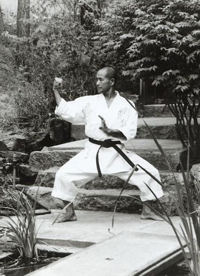
What followed was the toughest workout I’ve ever been through, before or since! Sensei had me working my hands till they wouldn’t work anymore. Knuckle pushups, followed by punches with 5 pound weights, followed by more knuckle push-ups, followed by more punches, followed by one hand pushups, and so on till my punches were hitting my knee caps because I couldn’t hold my hands any higher. Then it switched to my legs. Bunny hops around the dojo, kicks over the piano bench, followed by more bunny hops, followed by squat kicks, until I couldn’t get my feet off the ground. Then it was back to hands. Then back to legs. All the time Sensei was right there, pushing me to work harder, and punch faster and kick harder, for almost 3 hours. And when I was too exhausted to move, Sensei lined us all up for some randori. And after I had done randori with every student in the class, Sensei had me do tournament style fighting with one of the Green Belts, who promptly won the fight.
Sensei never said a word to me about humility, or the fact that I was acting a little too proud. But I understood the meaning of the training. And from that point on, whenever life would hand me a gift that made me start thinking of how proud of myself I should be, a little thought would arrive in my consciousness. “Careful, there may be some bunny hops and knuckle pushups around the corner. temper that pride!”
Of course, humility is an existential problem: As soon as we say of ourselves, “I’m humble now,” we aren’t anymore! The joke goes, “I’m proud of being humble!” Clearly, humility is something I still struggle with, but at least with a consciousness of it, for which I am eternally grateful to Sensei.
Consciousness is another gift. I think I was a pretty decent student, in that I almost always came to class, day in and day out. It was one of my better habits. But there is a problem with habits. They become rote. One night at practice, I was the senior Black Belt in attendance, positioned on Sensei’s right in the front row of class, a place of honor.
ED SUMNER, GO TO CORNER, 1,000 KNUCKLE PUSHUPS!
After warm-ups Sensei started us on a drill of standing basics and moving basics, and then started us on a new set of combination techniques. I was going through the motions just fine on everything to that point, but started struggling with the combination. Sensei stopped and showed me the techniques for the second time, and resumed the drill. I messed it up again. Sensei stopped and walked me through the combination yet again. And yet again I messed it up. “ED SUMNER, GO TO CORNER, 1,000 KNUCKLE PUSHUPS!”
“YES SENSEI!” I responded, as bowed, and thenI ran to the corner to do the pushups. But the little voice inside my head wasn’t saying “YES SENSEI!” It was saying, “why is he doing this to me? It’s humiliating. I’m the senior Black Belt here tonight for goodness sake!” Frankly, I was pretty mad at Sensei at that moment. But as I began to do my pushups, wondering if I could actually do 1,000 of them, my other interior voice began to answer the rhetorical question I’d posed.
Sensei isn’t doing this TO you, you dummy, he’s doing this FOR you!
“Sensei isn’t doing this TO you, you dummy, he’s doing this FOR you!” I realized that my training that night was severely lacking. I was there physically, but not mentally or emotionally. I was going through the motions. And I realized that Sensei was pushing me so hard, and holding me accountable for my effort with such discipline, so that I could achieve the goal I was working for.. to be as strong a Karate practitioner as my talent, intelligence and effort would allow me to be. And Sensei was doing so in total selflessness. Sensei would perpetually put at risk his students’ “liking” him, in order to propel them to excellence. Those of us who came to understand it truly came to not “like” Sensei. We loved him.
And the central lesson for me in this experience is the lesson of “be here now.” I wasn’t “there,” that night. My mind was clearly off somewhere else and not on my training. Sensei brought it back to where it belonged.
ED SUMNER, ENOUGH PUSHUPS – BACK TO TRAINING!
Now the part of this story that still feels a little eerie, is that at the exact moment I came to my epiphany as to why Sensei had sent me to the corner to do the 1,000 pushups (which probably came on about pushup number 12), Sensei shouted, “ED SUMNER, ENOUGH PUSHUPS – BACK TO TRAINING!” It was with great relief that I left 988 pushups undone and scampered back to the group. And the combination no longer seemed difficult. But I’ve always wondered about something. I’m pretty sure that Sensei doesn’t actually read minds, but was there some change in body language, or my enthusiasm for the pushups that told him I had “gotten it?” Or was the timing complete coincidence?
In any case, that mind set of truly being “in the moment,” focused on the task at hand and committed to achieving excellence NOW, has been a wonderful tool with which to approach just about every other aspect of my life.
There was a trip we took in my little VW bug down to a Tournament in Eugene, Oregon. It was sponsored by the Shotokan folks, and Mr. Nishiyama was there. Bruce, Steve, Bob and I all did rather poorly. If I recall correctly, it was the first tournament Sensei took me to.
YOU ARE RESPONSIBLE for the results, NOT the referee!
Sensei may not have intended to teach us much during that drive back to Spokane, but there are two things Sensei said that have really stuck with me. First, three other yudansha and I were busy rehashing the fights, and what had gone wrong. One of them, a shodan in a different style who had been training with us made some comment about how he’d really won his fight, but that the referee was blind, or some such nonsense. Sensei wasn’t buying it. “Not referee problem!” he said. “Your training problem! You must train so hard and so well that even a blind referee can see that you’ve won. YOU ARE RESPONSIBLE for the results, NOT the referee!” Wow. Not the referee’s responsibility. Not my Sensei’s. Not my wife’s, or my Mom’s or my friend’s. MINE. And I guess that if that concept applies to winning a tournament, it may also apply to everything in life. Kinda takes away excuses.
And Sensei said, “part of problem is you see yourselves as you used to be.
Second, as the four of us were rather glum from our defeat, we were “beating ourselves up” a little. “I’m just not very good.” “I’m too slow.” “I’m too stiff.” That kind of stuff. And Sensei said, “part of problem is you see yourselves as you used to be. The junior students see you as you are, and are quite impressed. I see you as you are going to be. When you see yourselves as I see you, you’ll win tournaments.” And Sensei was right.
OH! I’m one of Sensei’s students. I should be kicking butt!
The first time I won a championship came because of a funny reason. I watched two of my training partners lose their first fights in the lightweight division. I was thinking, “they just didn’t fight well at all. They are both magnificent at the dojo, and tonight they looked like beginners! I know that the guys who beat them don’t train nearly as hard as they do. And I know that those guys don’t have the benefit of Sensei’s teaching. Sensei’s students should be kicking butt!” Then, “OH! I’m one of Sensei’s students. I should be kicking butt!” And as soon as I thought that, I could see myself carrying the trophy for Grand Champion home. And that’s what happened.
Since then, in any goal I’ve pursued, I’ve tried to see myself “how I will be” after doing the hard work, learning the skills, practicing the techniques. Looking into the future “as if” I was already there has always accelerated the process. More importantly, when I’m training and coaching young folks who work with me, I try to see them “as they will be.”
Often, when I was traveling in my work, I’d visit local Dojos so that I could do some training on the road. One benefit of this was making some wonderful friends along the way. Another was having the opportunity to let some of these folks get a little glimmer into what training with Sensei was like. Frequently I’d be asked to be “guest Sensei” for a training session. Of course, I’d do my best to train those folks as well as Sensei trained us, and in the same spirit.
FIFTY PUSHUPS! NO SLEEPING IN CLASS! SIT UP STRAIGHT!
I remember visiting with some folks near Salt Lake City Utah. The Sensei asked me to lead the class. At one point, I told the junior students to sit and watch as I worked with some of the brown belts. In the course of training, I glanced over to see one of the senior green belts laying back, legs out straight in front of him, looking half asleep. Without thinking, I responded as Sensei would have. I spun to face the lazy boy, pointed at him and yelled, “FIFTY PUSHUPS! NO SLEEPING IN CLASS! SIT UP STRAIGHT!” I thought the poor kid was going to die on the spot. He obviously wasn’t used to the kind of Dojo Discipline that I was used to. He did the pushups, and then sat at rigid attention until told to get back into class formation.
Frankly, I think the whole dojo was a little stunned. After class, we all went for pizza, and the poor student I’d yelled at politely asked, “Sensei, may I ask a question?” “Of course,” I said. “I realize I shouldn’t have been lying down instead of sitting properly, but why do you yell, and make us do pushups when we make a mistake?” I hadn’t really given it a lot of thought till that point, but realized I needed to make some sense of it for him. “Part of the purpose of training isn’t just to learn to punch and kick. It’s to create a new level of awareness. If I’d just walked over and said, ‘excuse me, but it would really be safer for you if you sat up straight,’ you might have changed posture without changing attitude. When I yelled at you and made you do pushups, what happened to your sense of awareness?” “I got pretty aware. I was scared not to be aware!” “Good!” I said. I turned to some of the other students, and asked them, “what happened to your awareness after I yelled at him?” “I didn’t want to have to do fifty pushups too, so I was on pins and needles the rest of the class!” said one of the kids. “OK, so now imagine that every time you come into the Dojo, you maintain that kind of awareness. Do you think that might become your new habit?” They agreed that it would. “So, if that’s your habit, would it carry over to the street?” They thought it might. “Good! Because if you are going to be mugged, the mugger isn’t going to come over and gently say, ‘excuse me, I’m going to mug you in a few minutes, so you might want to start getting ready.'” “No, a mugger is going to try to give you a much worse surprise than I did tonight, and if your awareness is like it was in class, it will be too late for you to try defending yourself. But if you are truly aware and alert, if that becomes your habit, a mugger won’t have a chance. He won’t even try anything, because he’ll SEE that you are aware and alert. Creating good habits in the dojo is what will create good habits for the street.” I gave voice to that in explaining to the students, but Sensei taught me that by example. And I’ve found that maintaining a habit of awareness and alertness serves well in driving, riding motorcycles, and even in business.
Training with Sensei provided me with so many lessons, in so many areas. How to put rocks in just the right place in a Japanese garden. How to be responsible for a team of kohai during Gasshuku. And my first foray into management came under Sensei’s tutelage.
When I want to get something done, get a busy person to do it!
I was a pretty busy guy back then. (Some things never seem to change.) I was carrying 18 credit hours at Eastern Washington University, working two part-time jobs, and training about 20 hours a week on average. I remember Sensei sitting down with me one Sunday and saying, “Ed, I want you to be the Tournament Director for the Annual College Tournament this year.” I wasn’t quite able to say “no,” to my Sensei, but I did make an attempt to convince him that I wasn’t the best person for the job. “Well, Sensei,” I said, “I don’t have much time to devote to something like that.” “I’m going to school, working, and training. I hardly get to sleep as it is!” I suggested another member of the Yudansha. “You know, he has lots of time available. At the moment, he isn’t going to school, and only has a part time job.” Sensei’s response was “if I ask him to do it, it will never get done. If you want to get something done, get a busy person to do it.” I thought for a moment about the times Sensei had pushed me in training to exceed my self-perceived limits, and decided that this might be a similar experience. I agreed to be the Tournament Director. I had to start by figuring out what a Tournament Director did! Well, with the help of many of my fellow students that I “volunteered” into parts of the project, we pulled off a nice little Tournament! In doing so, I learned about scheduling, promotion, delegating, and leadership. That experience has served me very well through my business career. And the most important part of it was, hen I want to get something done, get a busy person to do it!
Great leaders don’t create good followers.
Perhaps the most important lessons of all were the most subtle. The ones that took years of participation and observation. I realized that Sensei was not only a great teacher, but a great leader as well. Sensei wasn’t trying to lead a political movement, or a business venture. He was leading us to be the best Karate practitioners, and the best people, we could be – physically, spiritually and morally. Great leaders don’t create good followers. They create more leaders. That is what Sensei did.
I learned that to be an effective leader, I needed to genuinely care about what was best for those I wanted to lead.
I learned that to be an effective leader, I needed to genuinely care about what was best for those I wanted to lead. I learned that I had to lead from the front. I learned that what I say and what I do have to match… even when it might be painful or inconvenient. I learned to hold those I lead, and myself, to the highest standards. And I learned that to be an effective man, requires a continuous commitment to integrity and character, as so wonderfully demonstrated by my Sensei. I won’t tell you that I’ve always achieved that goal. My road to growth and understanding has had its bumps and potholes. But the example Sensei set for me has, at least so far, always brought me back to a straight path. And for that, I am eternally grateful.
For the last six years, I’ve been working with Sensei in developing a book. We had many face to face meetings, and a standing appointment for every Sunday morning at 7:00am to discuss the book. Sometimes we’d work on a section of the book, and sometimes we’d just visit. The book is essentially done. We expect to have the final editing completed soon, and we have an outstanding publisher ready to take it from there. Hopefully you will acquire this book when it goes on the market. You will get a much better insight into an incredible Karate teacher, Teruo Chinen Sensei. As for me, I will miss my Sunday morning visits with Sensei tremendously.
Ed Sumner, Nanadan, Okinawan Goju Ryu Karate, Jundokan International.

